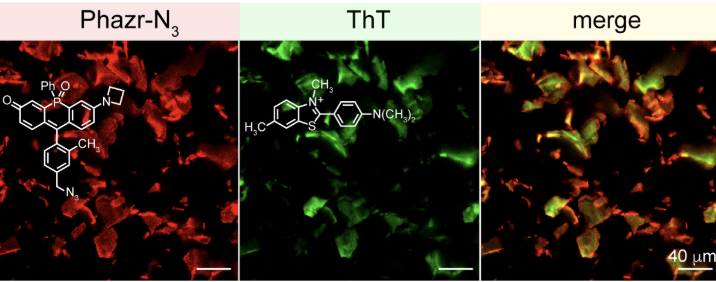Applications
- Advanced imaging tool for Alzheimer’s disease research.
- Detection and tracking of amyloid beta (Aβ42) aggregation in real-time.
- High-contrast staining of plaques for neuroscience studies.
- Foundational molecule for developing therapeutic compounds targeting Alzheimer’s peptide
Advantages/Benefits
- Unique ability to bind free Aβ42 peptides, making it useful for diagnostics and basic science assays
- Higher-contrast plaque visualization while minimizing interference from surrounding cells
- Over 4000-fold fluorescence signal above background for superior imaging
- Improved tracking of early-stage amyloid beta aggregation with high sensitivity and precision in real-time
- Potential scaffold for Aβ42-binding compounds
Background
Alzheimer’s disease is linked to the formation of plaques made from amyloid beta peptides (Aβ42). While these plaques are well-studied, smaller early-stage aggregates are thought to be the primary drivers of neurotoxicity. Existing imaging tools, such as Thioflavin T and Congo Red, are unable to detect these early species. Berkeley Lab researchers have developed Phazr, a novel fluorophore that enables real-time tracking of Aβ42 aggregation, from the earliest stages to fibril plaques, overcoming limitations of traditional probes.
Technology Overview
Berkeley Lab researchers have developed Phazr, a near-infrared fluorophore specifically engineered to monitor amyloid beta (Aβ42) aggregation with high sensitivity and precision. Phazr binds to Aβ42 peptides with low micromolar affinity, enabling real-time tracking of their progression from soluble forms to mature plaques. Its environment-sensitive spectral shifts and changes in fluorescence intensity allow for detailed observation of aggregation dynamics. Unlike conventional probes, Phazr delivers distinct, high-contrast staining of plaques while reducing interference from surrounding cells. Furthermore, it provides over 4000-fold signal enhancement for plaques without the need for wash steps, facilitating clear imaging in complex biological environments, including co-cultures with neural cells. This innovative fluorophore represents a transformative tool for studying the molecular mechanisms of Alzheimer’s disease and the critical early stages of plaque formation.
Development Stage
Proof of Concept
Principal Investigator(s)
- Line Kristensen
- Bruce Cohen
Status
Patent pending
Opportunities
Available for licensing or collaborative research
